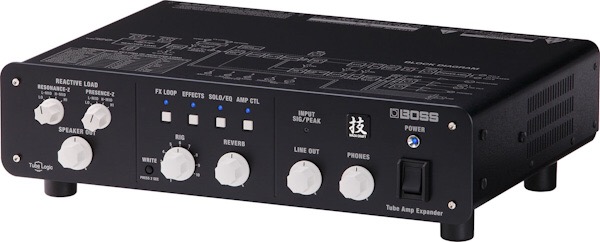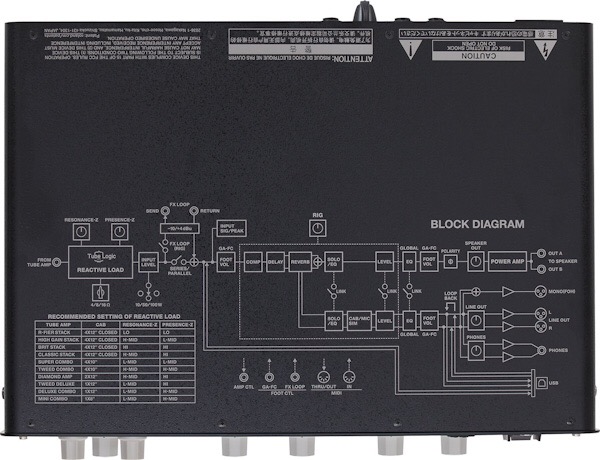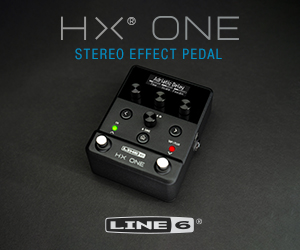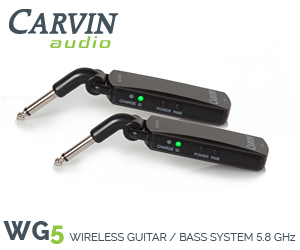Expansion, Not Extinction – The Boss Waza Craft Tube Expander Provides Hope for Tubes in an Increasingly Digital World
Phil Smith | Mar 22, 2020 | Comments 0

At Winter NAMM 2019, when Boss announced the Waza Tube Amp Expander (that’s already a mouth full name, isn’t it?), one might be forgiven if his first reaction was “Really? Just another stupid loadbox..and one that probably won’t work properly or won’t fit my needs?” But as we here at TheToneKing.com often discover, first impressions may not provide the whole picture.
When people say the tone is in the fingers, or in the wood, or in the pickups, or in. the strings, or in the current relative humidity (really! At least one famous musician has discussed this as a factor when recording). The guitar tone is a sum up of everything, a long and very complex equation of multiple factors with multiple variables. The reaction between the cab and the amp is one of them, and you probably can relate to the feeling when you play a real tube amp with a real cab. There’s some kind of organic response for every note you play, mainly when the amp is loud enough for the cab to interact with your guitar when the air moved by the speaker starts vibrating the body of your guitar.
Keep in mind that most of tones we know and love are from amps that were designed in the ‘50s and ‘60s. Even with amps evolving over the years and new tones being discovered, fundamental tube amp design really changed since the early days; they’re still using the same technologies. Over the years, many attempts of designing amps by using different technologies have been attempted with fantastic results; see the current state of modeling and impulse response technology. However, sometimes we can forget how great a real tube amp until we flip that big mechanical situation and watch those little bottles light up.
This is what is often hard to duplicate in digital systems. We might be able to reproduce some circuits, but we rarely have a complete setup that will reproduce the reaction and feel just as great. The same problem occurs when we use a real tube amp with a “dummy” fixed load instead of cab. So why bother with a digital amp or loadbox in the first place? Why miss out on the fun?
As far as I’m aware, the only real analog modeling alternative for preamps is the MGP-1A Preamp by Black Widow. That’s the only preamp with real analog circuit and real tubes that will get you pretty much all tones you need, with over 260 preamp models in a single 2U rack. If you want to check it, I recommend you an article I wrote about it. However that would only cover the preamp section (at least for now, wink wink).
Well, there are many reasons: flexibility, practicality, reliability, connectivity, and price are amongst the usual ones. Digital system generally have multiple amp models and quickly switch back and forth on stage or in studio to have a large palette of tones without the need for an 18-wheeler to transport your gear.
Even if all you need is one amp model and even if we would also cover the power section, we would still be missing one major link in the whole signal path, however. That is the relation between the amp and the cab. With this kind of rig, you can crank the amp up to have enough electricity in the tubes to get the perfect sweet tone that will react perfectly with the speaker and be in perfect harmony with the guitar — but it might get very loud!
That’s where the loadbox comes in. If you don’t want to use cab, you will need a way to have a substitute load to ensure your amp functions properly. The concept of loadbox isn’t something new, however in the past, it was just a big constant resistance, a.k.a “dummy” load.
In the last decade or so we’ve seen many companies offer reactive loadboxes and The Tone King has talked and/or reviewed many of the most famous ones, including the Fryette Power Station, the Rivera RockCrusher, the Two-Notes Torpedo, and the Universal Audio Ox.

As a tube amp owner/user myself, I’ve looked at all those products and, for some reason, it seems like they’re always missing something. I believe it’s because, generally, we just don’t only want a loadbox. We’re actually trying to find a way to expand the capabilities of your tube amp to make it more usable as we could with a modern and digital system.
For instance, you may want to adjust the overall volume of your cab and use the loadbox as an attenuator. But you might also need a direct out so you’re able to use the loadbox as a pass through to attenuate your cab AND have a signal that would go to your audio interface in studio, to the front-of-house when you’re on stage, or even a headphone output for in-ear monitoring or working where silence is needed. In the later cases, you may benefit from having cab emulation on that signal. You might also need a way to recall multiple rig presets to be able to quickly switch between presets like you would do with a digital system. might want to add a loop to have your effect if you’re using an amp that might not have any. You might want all of that to be controllable from a midi switcher on your pedalboard, or maybe have a good app on your computer to build out and control your signal flow. After all, that’s what you’d do with a digital system and what you’d expect from a “modern version” of what a tube amp should, or is expected to be, today.
Don’t get me wrong, some of the loadbox such the Two-Notes Torpedo/Captor, or other famous ones currently on the market, are working great. However, it generally need two or three products to cover all features listed above between a loadbox, attenuator, IR Cab loader, D.I., and more.
That’s why I was quite skeptical when I first saw the Boss Waza Tube Amp Expander. I thought it would be another one of these loadbox that would be missing something that I would need. I have to admit that I looked into it and I couldn’t find anything that I would miss.
The Waza Tube Amp Expander is a 150W loadbox packed with a ton of features and connectivity options. It might look overwhelming at first, but keep in mind it’s always better to have a feature and not using it instead of not having it and needing it. I won’t be able to list them all and therefore will only focus on some of the top ones that caught my attention.

One of the top highlights of the Tube Amp Expander is actually something we don’t really see. It’s what Boss calls the “Tube Logic.” It’s a circuit that allows you to adjust the impedance tuning to correctly match the reactive load to your amp to retain its natural tone, dynamic feel, and distortion characteristics. You will have a load that will react and feel just as the cab you will select, making your amp sound like it would with a real cab.
Another feature I like is the fact the attenuator knob doesn’t have steps like a lot of loads have. Here, you can smoothly adjust the volume of your cab and won’t have to pick between one step being too loud and the next step being too quiet. There’s also a control output to manage effects, channels, or other connections like you might do on your amp like you would do with a regular footswitch, but it’s all handled through the Tube Amp Expander. You can change channels, engage a boost, turn on reverb, or any number of things depending on how you’re configured.
If you don’t have any reverb on your amp, don’t worry, Boss got you covered. Not only they did include a loop, which allows you to easily add outboard reverb to any amp that wouldn’t have any, Boss will also provides high quality effects such as reverb, delay, compressor directly from the onboard DSP, just like what you’d find on some digital modelers or pedals. The external loop offers selectable series or parallel operation, plus support for both line-level devices and standard stompbox effects. Of course, you can also have an EQ/boost that could be very practical on stage to adjust your rig to the room without redoing all your setting on your amp or pedalboard.
The Waza Tube Amp Expander also includes an USB port to connect to a computer and has a nice user interface in app form to fine-tune one of the ten rigs you can quickly recall later on from the front panel or remote control. You can have multiple mics setup on your cab emulation, from a large choice of various mic models. There are even slots for you to load your own favorite IRs.
I often wonder why tube amps don’t come with all those features already. One reason that come to mind would be additional cost on each amp. However, we live in a time where a lot of people are starting to value digital systems because it’s just more practical and convenient. It’s even to the point where we might ask ourselves if tube amps will actually survive.
Of course, we will always find them, even if it’s on a niche market, but would they still be the main choice for the majority of players?
I have to admit that with all progress made with digital systems, I’ve been convinced the tube amps might be something of the past couple decades from now. However, I can easily see an analog modelers such Black Widow complemented with this Boss Waza Tube Amp Expander, offering the perfect solution for guitarists that prefer the tone of analog equipment but want the flexibility and features that have become standard on digital systems so far. The Boss Waza Craft Tube Amp Expander might not only expand the capabilities of your tube amp, but might also save it from extinction.
Tiny URL for this post:
Filed Under: Featured • Reviews • Accessories • NAMM 2019 - Winter
About the Author: French by birth but Texan by heart, I had different careers in multiple areas that don’t really make sense when they’re all laid down on my resume. Amongst them I’m a former military officer (mainly confidential stuff I can’t talk about) — I’m a former network architect (the stuff with switches, routers, optical fibers, satellites and wireless things that allow people to be connected) — I’m a former R&D engineer and product designer (mainly for electronics instruments in the Music Industry) — I’m also a former sound engineer that worked in professional recording studios (but nobody cares about that anymore) — and I even thought once in my life I was someone almost important doing things almost awesome... Now I’m just a professional amateur spreading my 2 cents online about anything and everything to anyone with too much time in their hands — and if you’re reading this bio, you might be one of them that just wasted 2mn of your life you will never get back. Sorry...




















